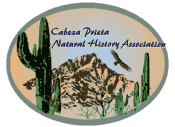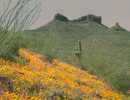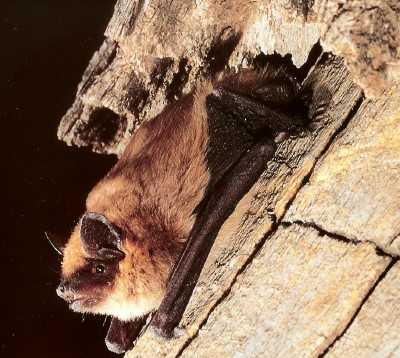
Cabeza Prieta Natural History Association
Sonoran Desert Mammals

Big brown bat
(Eptesicus fuscus pallidus)

|
Diet: insectivorous
Color: Dorsally tan to dark brown, ventral near pinkish to olivebuff. Face, ears, wings and tail membrane, black. Size: Length 110 to 130 mm (4.33 to 5.12 in) (Including tail of 38 - 50 mm.), Wingspan 330 mm (12.99 in.) (average) Active Period: nocturnal |
The big brown bat is closely associated with humans and is familiar to more people in the United States than any other species of bat. Its distribution is from southern Canada through southern North America into South America, including many islands in the Caribbean. Most summer roosts are in attics, barns, bridges, or other man-made structures, where colonies of a few to several hundred individuals gather to form maternity colonies. They move into caves, mines, and other underground structures to hibernate only during the coldest weather. Where most of these big brown bats winter remains unknown.
The big brown bat emerges at dusk and flies a steady, nearly straight course at a height of 6-10 meters (20-33 feet) in route to foraging areas. Its large size and steady flight make it readily recognizable. Apparently, some individuals use the same feeding ground each night, for a bat can sometimes be seen following an identical feeding pattern on different nights. After feeding, the bat flies to a night roost to rest; favored night roosts include garages, breezeways, and porches of houses.
Mating occurs in autumn and winter, the females store the sperm, and fertilization takes place in spring. Big brown bats normally bear twins in early June in the eastern United States, but in the western United States, usually only one baby is born each year. It is common throughout most of its range.
This article is from "Bats of the United States", 1999, by Michael J. Harvey of Tennessee Technological University, J. Scott Altenbach of the University of New Mexico, and Troy L. Best of Auburn University. Published by the Arkansas Game & Fish Commission, in cooperation with the Asheville Field Office of the U.S. Fish and Wildlife Service.
Photo Credit:
Photo #1
Copyright Creative Commons
HTML & Programing by
Thomas R. Powell